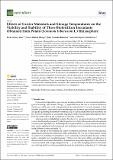| dc.description.abstract | Biofertilizer technology continues to be derailed by the short shelf life of inoculants. The present study investigated the suitability of wheat-bran (WB), rice-husks (RH), farmyard-manure (FYM), bagasse (BG), and sawdust (SD) in the formulation of potato-derived Klebsiella grimontii (MPUS7), Serratia marcescens (NGAS9), and Citrobacter freundii (LUTT5) under refrigerated (8 °C) and room (25 ± 2 °C) storage. The physicochemical properties of the materials were assessed before sterilization and introduction of the inoculants and assessment of their viability for 8 months. Most of the physicochemical properties of the materials varied significantly (p < 0.05). Bagasse supported the maximum growth of MPUS7 (5.331 log CFU g−1) under refrigeration and LUTT5 (4.094 log CFU g−1) under both conditions. Under room storage, the maximum growth of MPUS7 (3.721 log CFU g−1) occurred in WB. Formulations that remained viable under room storage can easily be integrated into existing agricultural distribution systems that lack refrigeration. | en_US |

